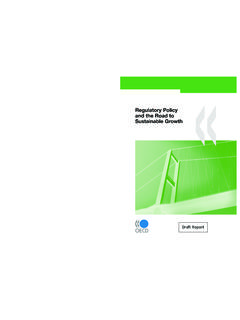Transcription of Global Regulatory Reform - EY
1 BCBS 239 Risk data aggregation and reporting A practical path to compliance and delivering business valueGlobal Regulatory ReformContents01 Banks can t do it all by 2016. They need to prioritize and make the right choices0102 Finding a meaningful and actionable framework to deliver against BCBS 239 principles0303 Coordinating in a practical way and using BCBS 239 to your advantage0704 How EY can help081A practical path to compliance and delivering business value01 Banks can t do it all by 2016. They need to prioritize and make the right choicesThe Basel Committee of Banking Supervision (BCBS) 239 is different from other regulations. It demands that the information banks use to drive decision-making captures all risks with appropriate accuracy and timeliness. By setting out overarching principles of effective risk management reporting and governance, BCBS 239 focuses banks on developing the right capabilities versus hitting a compliance date.
2 BCBS 239 isn t just about filling in another reporting template. Even after January 2016 (the compliance date for Globally Systemically Important Banks (G-SIBs)) it won t go are viewing BCBS 239 compliance through multiple lensesStress testing exercises such as the Comprehensive Capital Analysis and Review (CCAR) in the US, the Firm Data Submission Framework (FDSF) in the UK and the European Banking Authority (EBA) stress tests across Europe have emphasized the capability gaps banks have to bridge. The resources required to run these exercises are not alignment to the principles will also be challenged by other regulations including the Fundamental Review of the Trading Book (FRTB). If banks fail to demonstrate compliant solutions for data management, data governance and alignment between risk, finance and the business they will be forced to change the way they model and value their risk.
3 Without change, the rules will require a material increase in the level of capital banks need to hold. But it doesn t stop there. Other regulations such as the UK s Senior Manager Regime (SMR) will further intensify Board and Senior Management responsibility and accountability in the banking sector with a major focus on risk control. With the level of current and future change, BCBS 239 can, and should, be positioned at the heart of coordinating Regulatory have a lot of work aheadEvolving the way banks operate and adapting their supporting data and technology infrastructures will require a lot of work. Both the banks and their regulators recognize the challenges in fully aligning to the principles by January 2016. G-SIBs have mobilized and Domestic Systemically Important Banks (D-SIBs) are now mobilizing their approach to achieve Regulatory compliance.
4 A recent EY survey* on BCBS 239 readiness shows that banks are viewing the principles as an enabler for other strategic objectives aimed at transforming the business to survive in the new marketplace. Banks are, however, challenged in making the join between BCBS 239 principles, specific capability-based requirements and their existing book of work across different functional areas, lines of business and regions. This is often evidenced by a limited number of BCBS 239 initiatives, especially at divisional and regional limited investment spend, banks need to set the right priorities for 2015 Demonstrating sufficient progress to the regulator while also moving the organization towards it s existing strategic goals will be key. Banks need a practical method to address the challenges ahead: Translate principles into meaningful and measurable changes Understand the gap to target capabilities (calibrated against peers)* EY s BCBS 239 Autumn 2014 industry survey of 30 G-SIBs and D-SIBs on prioritizing and mobilizing projects for 2015 Connect strategic change across risk, finance, data and technology Gain sufficient momentum in 2015 and beyond with the depth and breadth of skills required to deliver Measure and monitor progress to January 2016 and demonstrate sustained alignment to the principles beyond 2016 Activities that deliver key capabilitiesEY s experience of BCBS 239 indicates that banks are prioritizing specific areas.
5 Data ownership and data quality frameworks Policy change Critical risk process documentation (including controls and key data elements) Service level agreements Data dictionary and lineageAvoid the cost of non-complianceBanks that continue to show deficiencies in their risk management capabilities may experience increased intensity of supervision and the possible application of capital add-ons and other limits on banks risk-taking and growth 2A practical path to compliance and delivering business valuePercentage of respondents per category<25%25% 50%56%22%22%50% 75%75% 100%Figure 1: What % of your BCBS 239-related change programs will be completed by January 2016?Key findings from EY s BCBS 239 Autumn 2014 industry survey of 30 G-SIBs and D-SIBs on prioritizing and mobilizing projects for 2015 Our survey (see figure 1) showed that most respondents think a significant part of their BCBS change delivery will not be complete by January 2016 89% of respondents viewed BCBS 239 as an enabler to shape their IT strategy and develop their IT infrastructure.
6 78% of respondents viewed BCBS 239 as an enabler for their enterprise-wide data management capability objectives. 67% of respondents viewed BCBS 239 as an initiative to help drive operational efficiency and other cost reduction practical path to compliance and delivering business value02 Finding a meaningful and actionable framework to deliver against BCBS 239 principlesThrough our experience of working with many G-SIBs and D-SIBs on their BCBS 239 self-assessment and compliance planning activities, EY has developed a Risk Data Aggregation and Reporting (RDAR) Framework. Banks can use this proven approach to manage change successfully, by integrating and delivering their BCBS 239 compliance objectives alongside their strategic investment s RDAR Framework presents a capability objective view through which banks can:Clearly articulate BCBS 239 compliance requirements and priorities1 Make the join across strategic change programs2 Align other Regulatory changes in a coordinated way3 Rapidly form an approach to successfully manage change4 Armed with a common language, banks can use BCBS 239 as a lever to align objectives and coordinate delivery.
7 Without such a Framework we have seen banks struggle to get a common understanding or consistency of response and measurement across the can use EY s RDAR Framework to create a common and meaningful understanding of the changes required across lines of business, functions and regions, and an approach to deliver the change in a coordinated and effective way. Banks can use the same framework to align strategic program objectives alongside BCBS 239-specific execution-level needs. Joining up the organization around BCBS 239 has clear advantages, both externally, in terms of demonstrating a cohesive response to the regulator, and internally, by prioritizing the development of risk management capabilities. EY s RDAR Framework is not just theory; it has been tried and tested with a number of clients and has been used to identify and define practical road maps towards FrameworkPeopleand organizationStrategyandgovernanceProcess es andcontrolsData and technologyAnalyticsanddecisionsupportStr ategy and governanceProcesses and controlsPeople and organizationAnalytics and decision supportData and technology Data governance Board and senior management accountability Risk policy and design principles Stress and crisis adaptability Key processes and controls Reconciliations Amendments and adjustments Capability and performance management Resource alignment Stress testing Risk matrix and measures Management information and reporting IT strategy and governance Golden sources and data lineage IT architecture and systems Data organization and definition IT
8 Performance Data quality End-user computingConclusiony 4A practical path to compliance and delivering business valueHow EY s Risk Data Aggregation and Reporting Framework can address banks challengesAs important Regulatory changes continue to sweep across the banking landscape, both regulators and banks want to do the right thing. They want to invest in a coordinated and strategic fashion to build a more performant and stable banking environment. Banks face a number of challenges from regulations being expressed in different ways, and implemented with different timescales and overlapping jurisdictional need to avoid a siloed response to managing Regulatory change if they are to build the right platform to develop their business, generate returns on Regulatory change spend and meet the challenge of today s market. To achieve this, banks need to connect the complex array of Global Regulatory changes in a way that has relevance to how they operate and that allows them to manage the required change.
9 EY s RDAR Framework supports this integration of priorities, using common capability objectives spread across the BCBS 239 principles to create the join. The Framework is helping banks to rapidly understand what BCBS 239 means to the way they operate, moving from principles to business-ready requirements. Banks have work to do across all components of the RDAR Framework. It can help banks articulate and prioritize change alongside organization-specific objectives with a number of common focus areas. The emerging priority areas of investment for 2015 include: Data ownership and data quality frameworks Policy change Critical risk process documentation (including controls and key data elements) Service level agreements Data dictionary and lineageAt most banks, existing investment programs have the potential to achieve much of the progress required toward BCBS 239 compliance.
10 Mapping specific BCBS 239 change demands against the bank s investment programs is critical to leveraging the committed investment in an efficient manner. With EY s RDAR Framework, banks can make the connection across their large scale finance, risk and data a common language of capabilities, joins are quickly identified, allowing for a rapid assessment of how much mutual value can be realized for both the BCBS 239 compliance work and the transformation Framework clearly articulates BCBS 239 compliance requirements and prioritiesRDAR Framework can help banks make the join across strategic change programs12 BCBS 239 Finance Improve data quality Harmonize data architecture Harmonize data governance Share data management and reporting servicesRisk Commoditize risk reporting activity Reduce time spent on data issues and generating reports Embed risk control standards Reduce cost and develop risk utilitiesData Improve data governance models Improve data accountability Implement data dictionary and standards Improve data quality5A practical path to compliance and delivering business valueThere are a number of new and enhanced















